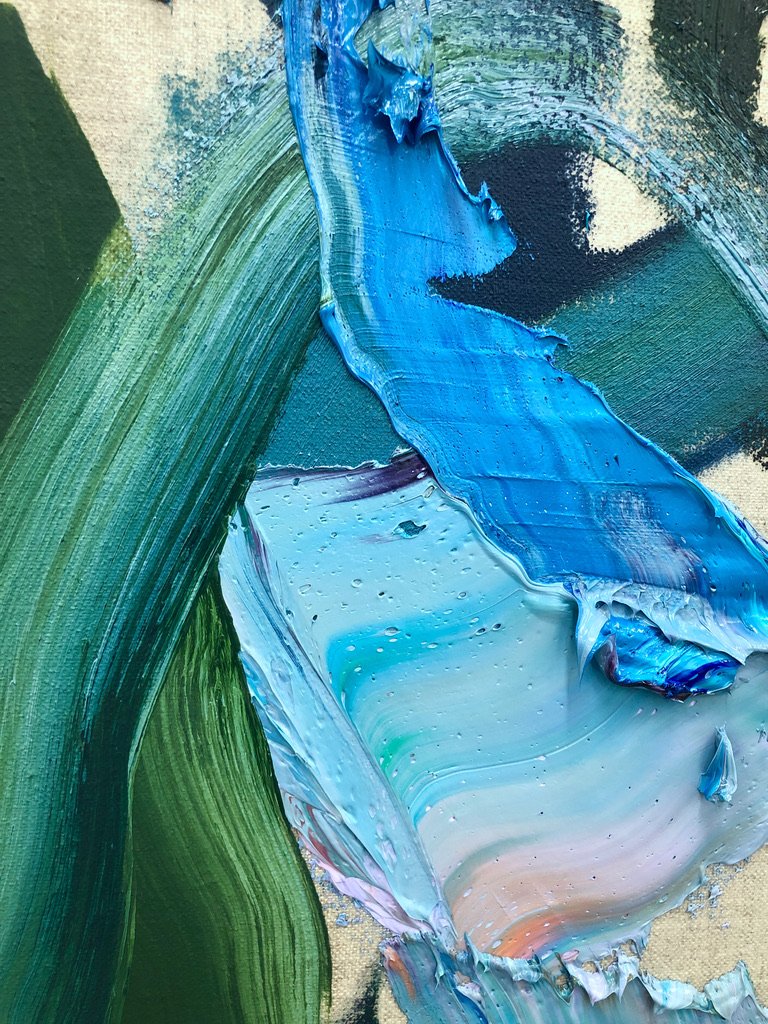Keening
December 2021 - May 2022
Te Manawa Museum
Te Papaioea Aotearoa New Zealand
Auhi Ana
Ko tāku e ngana ana kia peita hei whakamaumahara tātou
ki te uaua ā-ngākau kei a tātou. He nui nō te kiko o te peita
– ka kawea he tohu, he pūngao hoki e whakahārangi ana, e kāhuirangi ana, e rekareka ana rānei me ngā rongonga pērā i te tapakō, me te rere i te wā kotahi. Ka roa ake ngā tau e peita ana au, ka tūmatarau ake te āhua ki ahau.
Puta ai te papamuka i te peita; ehara i te mea he kōrero
oti ēnei peita. Ināhoki ko ēnei ko te kōhao i ngā kōrero, e whakaatu ana i te hanga ia me te tangatanga. Ko te wetekia i te paepae. Ko ngā peita tonu ka noho hei paepae mā te waihanga i tētahi kiri tuarua hei arotahi, hei whakamīharo.
Mā taku mahi i te taiwhanga toi kua takitaki i taku whakapapa Pākehā, e kimi ana i te wā i te neke taurangi i waenganui i ngā ao – i mua i tā tātou tino mōhio ki ngā kōrero whakawehe, kōrero tāmi o te whakataiwhenua. Nōku e rapu ana i ngā mātanga reo-paepae i kitea ngā kaitangi o te ahurea Celtic, ko tā rātou (i tētahi matenga) hāunga ētahi atu mahi, he auē, he tangi kia rere pai ai te wairua o te tangata mate, ā, kia auhi pai te hunga ora e tuku pai atu ai i tō rātou rāwakiwaki i taua wā tonu. Ko tā te kaitangi he wewete i tō te ao āhua ia, e āhei ai te ao ki te whakahou i a ia anō hei wāhi noho.
Te wewete, te whakahou – mā ngā kare ā-roto – ko ēnei aku tīwhiri taiwhanga hei mahi mā te peita.
Ka whakaihi tēnei whakaaturanga i ērā tāngata e mahi ana
i ngā mahi whakahou i ētahi atu paepae – ki ngā kaitangi, kaikaranga, tapuhi, mātanga rongoā, kaiwhakamauru, kaitito kanikani, kaituku haumanu, me ngā kaiwhakaora hei whakaingoa i te tokoiti. Ki ngā tāngata e noho ana i waenga
i ngā ao e rua, tae atu ki ērā e noho ana i waenga i ngā ira tangata – ko mātou tētahi hunga e tiaki ana i ngā paepae o te ao kia kore ai e katia. Ki ngā mātanga o te taiao māori: ngā waikure, te atatū, te kākarauri – nei te mihi atu mō koutou e whakaatu ana me pēhea e ora pai ai i te ao waenganui nei.
Ki a rātou nā ō rātou kōiwi i whakaawe ēnei peita, i tū tahanga noa me te kanikani atu i te pari o mōhio, ki roto ki tētahi kauhanga tuatoru nei, ka mihi.
Ki ngā tāngata katoa e toro mai ana ki tēnei whakaaturanga, nau mai, ko tā ngā peita nei he whakamihi ki tēnā e mauria mai e koutou, mai i tēnā wewete, i tēnā wewete, tērā i te mōhiotia e koutou.
Keening
I try to make paintings that remind us how much emotional muscle we have. The materiality of paint holds a lot - it can carry gestures and energies that are unsettling, disturbing or blissful, and sensations like plummeting and flight, simultaneously. The more years I spend painting, the more magical this seems to me.
The raw linen shows through the paint; these paintings are not whole stories. If anything, they’re the holes in stories, showing themselves being made and undone. Untethering at the threshold. Paintings themselves can work as thresholds, by creating a literal second skin to move through, to feel moved.
Studio life has found me tracing back through my Pākehā genealogy, looking for when we were last fluent in moving between worlds - before we were fluent in the separation and domination narratives of colonisation. Looking for threshold- language mentors, I rediscovered the keeners in Celtic traditions, whose practice (at a death) among other elements, involves wailing, so that a deceased spirit can pass over fully, and the living are moved to let loose the wildness of their grief, then and there. The keener’s cry unravels the world as it is, so it can re-form enough to be lived in.
Unravelling and reforming - using feeling as the primary navigator - these have been my studio clues for working in paint.
This exhibition is dedicated to those who work in transformational practices at other thresholds — to the keeners, kaikaranga, midwives, rongoā practitioners, palliative carers, choreographers, therapists and healers to name a few. To people who the world makes liminal, including those who live between gender — ours are some of many bodies that keep the thresholds of the world from closing down. To experts from the natural world: the mangroves, the dawn, the dusk - thank you for showing us how to thrive at the in-between.
To the people whose bones sparked these paintings, who were open to their form dancing off the edge of recognisable, into a third space here, thank you.
To everyone visiting this exhibition, thanks for being here, these paintings acknowledge what you bring from the untethering you’ve known.
Exhibition wall text:
Detail: Sung from gold-seamed clay
'Sung from gold-seamed clay' 120x140 oil on linen
Gorse
Gorse
Quartz
Cloudscrape 120 x 140cm oil on linen
In the studio with True North
Detail: arc
Perennial 120 x 140cm oil on linen


















